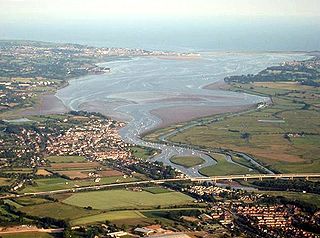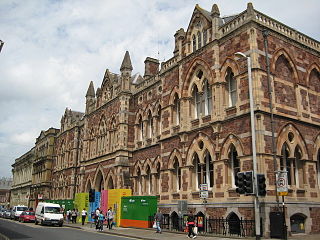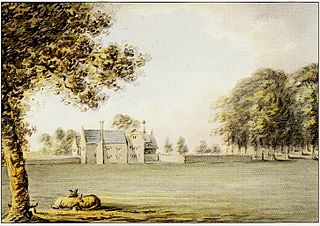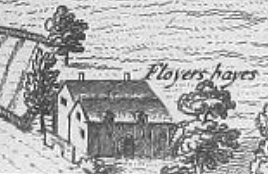
The River Exe in England rises at Exe Head, near the village of Simonsbath, on Exmoor in Somerset, 5.2 miles (8.4 km) from the Bristol Channel coast, but flows more or less directly due south, so that most of its length lies in Devon. It flows for 60 miles (96 km) and reaches the sea at a substantial ria, the Exe Estuary, on the south coast of Devon. Historically, its lowest bridging point was the Old Exe Bridge in Exeter, the largest settlement on the river, but there is now a viaduct for the M5 motorway about 2 miles (3.2 km) south of the city centre.

Tiverton is a town and civil parish in Devon, England, and the commercial and administrative centre of the Mid Devon district. The population in 2019 was 20,587.

The Roseland Peninsula, or just Roseland, is a district of west Cornwall, England. Roseland is located in the south of the county and contains the town of St Mawes and villages such as St Just and Gerrans. It is a peninsula, separated from the remainder of Cornwall by the River Fal.

Bovey Tracey is a town and civil parish in Devon, England, on the edge of Dartmoor, its proximity to which gives rise to the slogan used on the town's boundary signs, "The Gateway to the Moor". It is often known locally as "Bovey". It is about 10 miles south-west of Exeter and lies on the A382 road, about halfway between Newton Abbot and Moretonhampstead. The village is at the centre of the electoral ward of Bovey. At the 2011 census the population of this ward was 7,721.

Silverton is a large village and civil parish, about 8 miles (13 km) north of Exeter, in the English county of Devon. It is one of the oldest villages in Devon and dates from the first years of the Saxon occupation.

Modbury is a large village, ecclesiastical parish, civil parish and former manor situated in the South Hams district of the county of Devon in England. Today due to its large size it is generally referred to as a "town" although the parish council has not elected to give itself the status of a town as it could do under s.245(6) of the Local Government Act 1972, so it does not have a town council and cannot have a town mayor. It is also known informally as a "market town", as from at least 1199 the lord of the manor has held the right to hold a regular market. The village is situated on the A379 road, which links it to Plymouth and Kingsbridge. The current parish population is approximately 1,500.

Aylesbeare is a village and civil parish in the East Devon district of Devon, England, 8 miles (13 km) east of Exeter. According to the 2001 census, the parish, which includes the hamlet of Nutwalls, had a population of 527. Known for the Site of Special Scientific Interest on Aylesbeare Common that is managed by the Royal Society for the Protection of Birds, Aylesbeare was in the news during 1978 as the scene of the unresolved disappearance of the schoolgirl Genette Tate.

The disappearance of Genette Tate is a missing person case in which a 13-year-old girl disappeared while delivering newspapers in Aylesbeare, Devon, England, on 19 August 1978. Despite extensive searches, Tate's body has not been found and the cause of her disappearance remains unknown.

St Thomas is an area of Exeter and formerly a 3,700-acre (15 km2) civil parish and registration district in Devon, England, on the western side of the River Exe, connected to Exeter by Exe Bridge. It has a number of pubs, places of worship, several schools and a large shopping precinct. The population, according to the 2001 census, is 6,246, increasing to 6,455 at the 2011 Census.

Thorverton is a civil parish and village in Devon, England, about a mile west of the River Exe and 8 miles (13 km) north of Exeter. It is almost centrally located between Exeter and the towns of Tiverton, Cullompton and Crediton, and contains the hamlets of Yellowford and Raddon. The parish is surrounded, clockwise from the north, by the parishes of Bickleigh, Rewe, Nether Exe, Brampford Speke, Upton Pyne, Shobrooke, Stockleigh Pomeroy and Cadbury. Most of the eastern boundary of the parish is formed by the River Exe and the land rises westwards to 800 feet (240 m) at the border with Cadbury.

The murders of Eve Stratford and Lynne Weedon, two young women from London, England, occurred in separate, sexually motivated attacks by the same unidentified individual during 1975. Stratford was a bunny girl and Weedon was a schoolgirl who was killed almost six months later, on the other side of London. After Weedon's cold case was re-opened in 2004, new DNA techniques revealed that she and Stratford had been murdered by the same person. Stratford's case was re-opened in 2007, but neither case has been solved. A £40,000 reward for information leading to the capture of the killer remains on offer.

John Hayward (1807–1891) was a Gothic Revival architect based in Exeter, Devon, who gained the reputation as "the senior architect in the west of England".

Cowick is a suburb of the City of Exeter in Devon. Historically it was a manor situated in the parish of St Thomas, Exeter, within the hundred of Wonford. It was formerly the site of a Benedictine monastery.

Exeter is a cathedral city and the county town of Devon, South West England. It is situated on the River Exe, approximately 36 mi (58 km) northeast of Plymouth and 65 mi (105 km) southwest of Bristol.

Floyer Hayes was an historic manor in the parish of St Thomas on the southern side of the City of Exeter in Devon, England, from which city it is separated by the River Exe. It took its name from the ancient family of Floyer which held it until the early 17th century, when it was sold to the Gould family. In the 19th century the estate was divided up and the manor house demolished. The parish church of St Thomas, situated a short distance to the west of the house, was burned down in 1645 during the Civil War, and was rebuilt before 1657. Thus no monuments survive there of early lords of the manor, namely the Floyer family.
Ann Heron was a British woman who was murdered on 3 August 1990 at her home in Darlington, County Durham, by an unidentified killer. The case was heavily featured in British media as well as on the BBC programme Crimewatch in October 1990, but her murder remains unsolved.

Jacqueline Susan Ansell-Lamb and Barbara Janet Mayo were two young women who were murdered in separate incidents in 1970. Both women were last seen hitch-hiking along motorways in England, and both were sexually assaulted before being strangled to death.

The murders ofKate BushellandLinda "Lyn" Bryant, a 14-year-old schoolgirl and a 41-year-old woman, respectively, occurred in separate incidents of West Country, England. The events occurred in 15 November 1997 and 20 October 1998 respectively. The similar circumstances of the murders led investigators to conclude that there is a high possibility the murders are linked, with both killed with knives while walking dogs along isolated lanes.





















